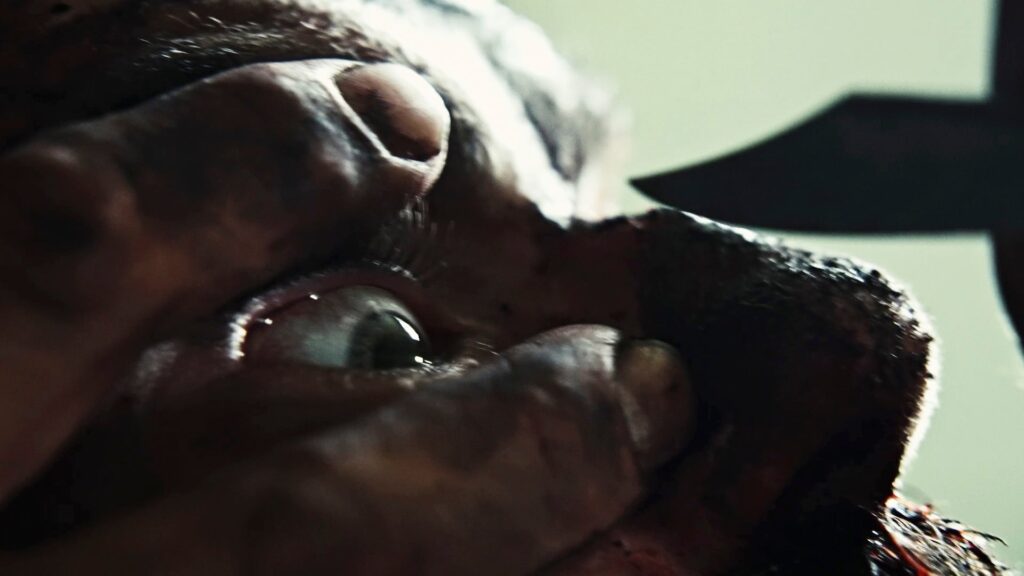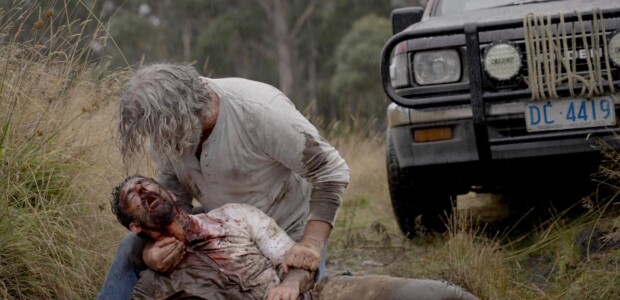Australian horror cuts deep — its offerings of raw, visceral terror often leaves its mark on the mind. Flicks like LAKE MUNGO and WOLF CREEK have been permanently seared into the zeitgeist for their gut-churning imagery and vicious antagonists paired with eerie underlying narratives.

Welcome Villain Films’ latest film, BEATEN TO DEATH, is directed and written by up-and-coming horror director Sam Curtain, known for THE SLAUGHTERHOUSE KILLER and BLOOD HUNT.
Set in a weathered, desolate shack deep in the nightmarish landscape of Tasmania, Australia, Curtain quickly kicks off his latest gorefest.
He drops his audience in the middle of a grindhouse-style fight between everyman Jack (Thomas Roach) and Ricky (Justan Wagner), a hulking, knife-wielding, leather vest-clad thug that has killed Rachel (Nicole Tudor), the former’s wife. On the brink of death — and despite being beaten to a bloody, snotty pulp — Jack overpowers his tormentor.
Despairing over the death of his wife and in need of medical treatment, Jack struggles through the desolate wasteland to look for help, only to run afoul of more trouble — and torture.
BEATEN TO DEATH — while remarkable for its stylistic grittiness, effective SFX, and Roach’s tangibly pained performance — feels like the skeleton of a great psychological thriller. The story ideas, the gut-churning splatter, and the setting is there, but it doesn’t feel complete.
The film uses non-linear storytelling to interweave the backstory of Jack and Rachel, how they met, and how they crossed paths with Ricky. Concurrently, we watch Jack trudge through rotting brambles, thorns, and sun-scorched fields of scrubland, permanently blinded by Ricky’s brother, Ned (David Tracy), who cuts out Jack’s eyes and crudely crucifies him against a wall in one of the film’s most shocking moments.

The erratic choice to structure BEATEN TO DEATH as a non-linear story does a disservice to the film. Because of the frequent scene jumping and flashbacks, it’s easy to be yanked from the narrative and to become disoriented, especially in the shift in status of Jack’s eyes and the film’s final minutes.
While highly admiring Roach’s performance (he’s got one hell of a grief-stricken cry, and by God, do you feel for him), the film is drawn out. It drags on as slowly as Jack does when he’s pulling himself through the bush.
BEATEN TO DEATH really drives home our protagonist’s sorrows and his plight, which is effectively done—it’s just perhaps not enough to support the plot of an entire feature film.
Despite all of its violence and gore, BEATEN TO DEATH doesn’t feel like a horror film. What happens to Jack is horrifying, of course — but we don’t see enough of Ned or Ricky to be scared of them.
What they do is gross and terrible, but what makes them scary?
Unfortunately, these two characters aren’t dug deep enough into, and therefore, their presence feels like a missed opportunity.

Though I try not to compare films — as circumstances and budgets vary so greatly — it’s impossible to not revisit the character of Mick Taylor, WOLF CREEK’s notorious, demented killer. The idiosyncratic nature of that character was written uniquely and tightly enough to transcend time; Mick’s still scaring audiences almost 20 years after the film’s release.
It would have been great to see a deeper, memorable dive into Ned and Ricky’s psyches rather than spend so much time focused on Jack’s harrowing despair.
Though BEATEN TO DEATH is the framework of a great psychological terror tale, it shows incredible potential, and offers a gnawing, realistic cruelty that some films struggle to achieve.
In reflecting on BEATEN TO DEATH and looking at Curtain’s terror-fueled filmography, he’s got passion, and a love for shocking his audience.
I’m eager to see what comes next from him, and to see him grow as a horror director and writer.
Tags: Australia, Benjamin Jung-Clarke, David Tracy, Justan Wagner, Nicole Tudor, Sam Curtain, Thomas Roach, violence



No Comments